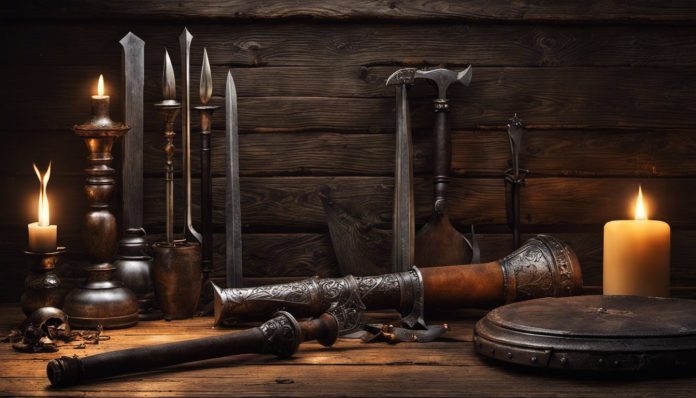Imagine a battle scene from the medieval era, full of warriors charging into combat. Among all the deadly weapons they wielded, one simple yet fearsome tool stands out – the club or bludgeon.
With its heavy head delivering powerful strikes and its role in countless coats of arms, this weapon holds an intriguing piece of history. In our journey exploring historical weapons, we will unearth the tale behind this fascinating bludgeon and why it was so successful on medieval battlegrounds. Ready for a trip back to the Middle Ages?
Table of Contents
History of Medieval Club (Bludgeon)
The medieval era bore witness to the invention and use of the club or bludgeon, a weapon designed for close combat. Typically wielded with two hands, these blunt weapons served as an alternative to swords during warfare.
Over time, clubs evolved into different types including the mace, characterized by a heavy head on the end of a handle.
Wooden clubs played an essential role in battles and conflicts throughout this period. The throwing stick, in particular, made out of flint proved crucial to many armies’ arsenals.
Peasants utilized tools like cudgels for self-defense as well as walking aids when journeying long distances. One notable form was the ovoid-headed club composed of shale attached to a wooden shaft that gained popularity within several communities across Europe.
How it Was Used
The medieval club or bludgeon served different purposes in warfare and daily life.
- Soldiers wielded it for blunt-force trauma during close combat.
- Against heavily-armored opponents, maces, a type of bludgeon weapon, were often used instead.
- Its short-distance striking capability made it a common choice among fighters.
- In everyday life, the club could serve as a tool for grinding grain or other foods due to its heavy head.
- Apart from combat, it found uses in hunting small animals.
- The various names such as cudgel or cosh reflect its wide range of applications in medieval society.
Similar Types of Clubs
Throughout history, several types of clubs that resemble medieval clubs were used in close combat. These weapons, including the mace, morning star, cudgel, flail and others shared some similarities but also had distinct differences. Check the table below and compare them.
| Type of Club | Similarities | Differences |
|---|---|---|
| Mace | Like the medieval club, the mace was often wielded with two hands for greater power and control and could cause blunt-force trauma. | However, the mace often featured a metal head, which was sometimes flanged or spiked, attached to a long wooden or metal handle. |
| Cudgel | A cudgel, like a club, was a simple weapon used for close combat. | It was usually made of hardwood and was lighter than a club, making it faster to swing but less lethal. |
| Flail | A flail could be used to inflict significant blunt-force trauma like a club. | But it had a unique design with a handle connected to a striking part by a flexible chain or rope, allowing for a wider range of attacks. |
| Spiked Club | The spiked club shared the ability to cause blunt-force trauma with the medieval club. | Its defining characteristic was the presence of spikes, which could cause additional piercing damage. |
| Shillelagh | The shillelagh was used for close combat, similar to the medieval club. | It was traditionally made from blackthorn or oak, was shorter than a club, and often had a large knob on one end that could be used to strike an opponent. |
These variations of the club played crucial roles in warfare and personal defense throughout the medieval era, each with their unique characteristics enhancing their effectiveness in an open battle or castle defense.
FAQs
1. What is a medieval club or bludgeon?
A medieval club or bludgeon is a type of weapon used during the Middle Ages that was typically made of wood and designed for blunt force attacks.
2. How were medieval clubs or bludgeons used in battle?
In battles, soldiers used clubs and bludgeons to strike against armored opponents, aiming to inflict shock damage through the armor.
3. Were clubs and bludgeons only weapons of war?
No, aside from warfare, clubs and bludgeons also served as tools for hunting or personal defense during the Medieval ages.
4. Did all cultures use clubs or bludgeons during the Medieval period?
Yes, though design varied significantly between regions, virtually every culture utilized some form of club or blunt weapon throughout history.
5. What materials were commonly used to make these weapons?
Medieval clubs and bludgeons were primarily crafted from hardwoods due to their strength and durability. Some might have been reinforced with iron strips for added effectiveness.

